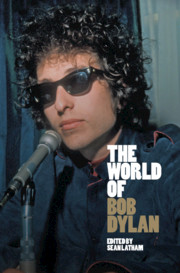Book contents
- The World of Bob Dylan
- The World of Bob Dylan
- Copyright page
- Contents
- Contributors
- Acknowledgments
- Introduction: Time to Say Goodbye Again
- Part I Creative Life
- Part II Musical Contexts
- Part III Cultural Contexts
- Part IV Political Contexts
- Part V Reception and Legacy
- Chapter 24 The Bob Dylan Brand
- Chapter 25 The Nobel Prize: The Dramaturgy of Consecration
- Chapter 26 Dylan: Stardom and Fandom
- Chapter 27 The Bob Dylan Archive®
- Further Reading
- Index
Chapter 27 - The Bob Dylan Archive®
from Part V - Reception and Legacy
Published online by Cambridge University Press: 21 April 2021
- The World of Bob Dylan
- The World of Bob Dylan
- Copyright page
- Contents
- Contributors
- Acknowledgments
- Introduction: Time to Say Goodbye Again
- Part I Creative Life
- Part II Musical Contexts
- Part III Cultural Contexts
- Part IV Political Contexts
- Part V Reception and Legacy
- Chapter 24 The Bob Dylan Brand
- Chapter 25 The Nobel Prize: The Dramaturgy of Consecration
- Chapter 26 Dylan: Stardom and Fandom
- Chapter 27 The Bob Dylan Archive®
- Further Reading
- Index
Summary
On June 11, 2019, music journalist Jody Rosen published a bombshell report in the New York Times Magazine about a devastating fire on the Hollywood backlot of Universal Studios.1 The fire itself wasn’t “news” per se, or at least it shouldn’t have been; it had happened eleven years earlier, in June 2008, and had been reported in the media. Initial reports estimated the damage to Universal’s video vault assets to be extensive, but in the end, relatively inconsequential. Chief Operating Officer of Universal, Ron Meyer, told reporters that “Fortunately, nothing irreplaceable was lost. The video library was affected and damaged, but our main vault of our motion picture negatives was not.”2 But what went unreported were the massive losses to their audio archives. The biggest of the “Big Three” record labels (valued at $33 billion, ahead of Sony Music and Warner Music), Universal Music Group rose to prominence through acquiring dozens of other record labels, including classic and legacy imprints such as ABC, A&M, Decca, Chess, Geffen, Impulse, Interscope, and MCA. All told, the fire destroyed the master tapes of more than eight hundred artists spanning decades of musical history across numerous genres – approximately 175,000 assets and a half-billion song titles. The list of artists whose work was destroyed in the fire reads like a who’s who of popular music, folk, blues, and jazz, and the work included not only commercially released recordings, but also recordings that have never seen proper release. The effect on the history of recorded music is immeasurable.
- Type
- Chapter
- Information
- The World of Bob Dylan , pp. 325 - 334Publisher: Cambridge University PressPrint publication year: 2021



